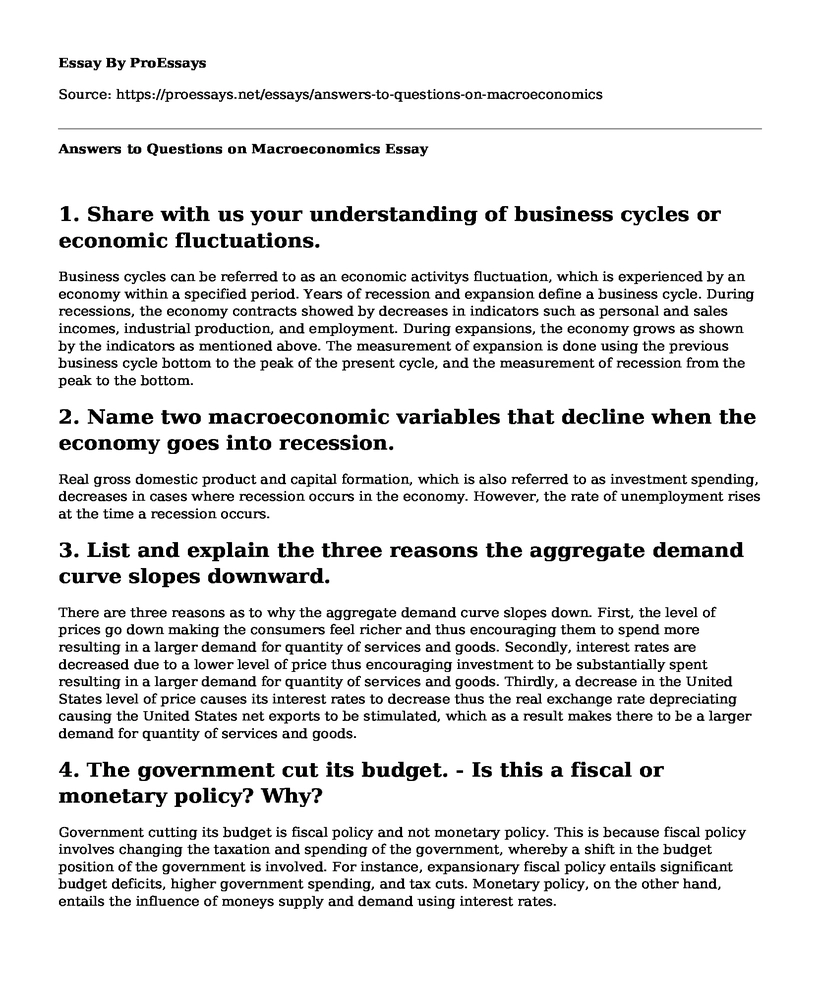1. Share with us your understanding of business cycles or economic fluctuations.
Business cycles can be referred to as an economic activitys fluctuation, which is experienced by an economy within a specified period. Years of recession and expansion define a business cycle. During recessions, the economy contracts showed by decreases in indicators such as personal and sales incomes, industrial production, and employment. During expansions, the economy grows as shown by the indicators as mentioned above. The measurement of expansion is done using the previous business cycle bottom to the peak of the present cycle, and the measurement of recession from the peak to the bottom.
2. Name two macroeconomic variables that decline when the economy goes into recession.
Real gross domestic product and capital formation, which is also referred to as investment spending, decreases in cases where recession occurs in the economy. However, the rate of unemployment rises at the time a recession occurs.
3. List and explain the three reasons the aggregate demand curve slopes downward.
There are three reasons as to why the aggregate demand curve slopes down. First, the level of prices go down making the consumers feel richer and thus encouraging them to spend more resulting in a larger demand for quantity of services and goods. Secondly, interest rates are decreased due to a lower level of price thus encouraging investment to be substantially spent resulting in a larger demand for quantity of services and goods. Thirdly, a decrease in the United States level of price causes its interest rates to decrease thus the real exchange rate depreciating causing the United States net exports to be stimulated, which as a result makes there to be a larger demand for quantity of services and goods.
4. The government cut its budget. - Is this a fiscal or monetary policy? Why?
Government cutting its budget is fiscal policy and not monetary policy. This is because fiscal policy involves changing the taxation and spending of the government, whereby a shift in the budget position of the government is involved. For instance, expansionary fiscal policy entails significant budget deficits, higher government spending, and tax cuts. Monetary policy, on the other hand, entails the influence of moneys supply and demand using interest rates.
5. FED recently raised the bank reserve rate - what policy is this, monetary or fiscal? Why?
FED raising the bank reserve rate is monetary policy since monetary policy entails influencing moneys supply and demand mainly through the use of interest rates. Also, monetary policy can involve policies that are unorthodox like quantitative easing and open market operations
6. How does the theory of liquidity preference help explain the downward slope of the aggregate-demand curve?
According to Keynes liquidity theory, the aggregate-demand curve slopes down due to three reasons. First, according to the theory, the demand for money is raised as a result of a higher level of price. Secondly, a higher demand for money results in interest rates that are higher. Thirdly, the demanded quantity of services and goods decreases due to interest rates that are higher. Consequently, there is a negative relationship between required quantity of services and goods and the level of price.
7. Give an example of a government policy that acts as an automatic stabilizer. Explain why the policy has this effect.
A good example of policy as affected by the government and that takes the form of an economic stabilizer is the tax. This is because the amount of tax collected by the government drastically decreases given that a significant portion of all the collected tax is closely tied to economic activities.
8. What is "natural" about the natural rate of unemployment? Why might the natural rate of unemployment differ across countries?
What is considered to be natural in regards to unemployments natural level or percentage is the fact that it is beyond monetary policys influence. Unemployments natural percentage is the logic behind the balance lying between employment and unemployment, where there is a fluctuation of the levels or percentage of unemployment. At the natural level, any individual willing to work within the present rate of real wage and has found employment is assumed to be under unemployment considered to be involuntary. However, there is always a certain percentage of unemployment that is voluntary, whereby some people opt to be out of work while looking for work.
There can be some differences across countries as far as unemployments natural rate is concerned because most, if not all, countries have different markets thus different labor policies and laws. Besides, the natural rate of unemployment might differ given that countries have different minimum wage laws, union power, and laws on collective bargaining among other factors influencing the conditions of the labor market.
Cite this page
Answers to Questions on Macroeconomics. (2021, Jun 28). Retrieved from https://proessays.net/essays/answers-to-questions-on-macroeconomics
If you are the original author of this essay and no longer wish to have it published on the ProEssays website, please click below to request its removal:
- Kroger Market Summary and Value Calculation
- Global Food and Feed Production Business Intelligence Dashboards Paper Example
- Digital Finance in Nigeria Paper Example
- Article Analysis Essay on Moral Globalization and Its Discontents
- Employee Turnover: Causes, Impact and Retention Strategies - Essay Sample
- Essay Example on Retention: High Challenge for Companies in This Era
- Nurse Deb's Case: Evidence Needed to Win Wrongful Termination Suit - Case Study Example







